Related Research Articles

Oliver Norvell Hardy was an American comic actor and one half of Laurel and Hardy, the double act that began in the era of silent films and lasted from 1926 to 1957. He appeared with his comedy partner Stan Laurel in 107 short films, feature films, and cameo roles. He was credited with his first film, Outwitting Dad, in 1914. In most of his silent films before joining producer Hal Roach, he was billed on screen as Babe Hardy.

Harold Eugene "Hal" Roach Sr. was an American film and television producer, director, screenwriter, and centenarian, who was the founder of the namesake Hal Roach Studios.
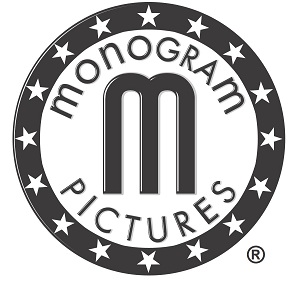
Monogram Pictures Corporation was an American film studio that produced mostly low-budget films between 1931 and 1953, when the firm completed a transition to the name Allied Artists Pictures Corporation. Monogram was among the smaller studios in the golden age of Hollywood, generally referred to collectively as Poverty Row. Lacking the financial resources to deliver the lavish sets, production values, and star power of the larger studios, Monogram sought to attract its audiences with the promise of action and adventure.
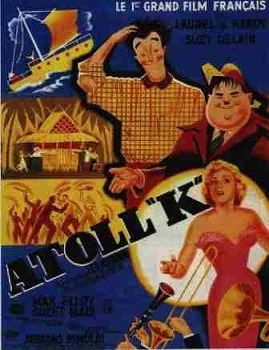
Atoll K is a 1951 Franco-Italian co-production film—also known as Robinson Crusoeland in the United Kingdom and Utopia in the United States – which stars the comedy team Laurel and Hardy in their final screen appearance. The film co-stars French singer/actress Suzy Delair and was directed by Léo Joannon, with uncredited co-direction by blacklisted U.S. director John Berry.
Robert Youngson was a film producer, director, and screenwriter, specializing in reviving antique silent films.

The Bullfighters is the penultimate feature film starring Laurel and Hardy, the sixth and final film the duo made under 20th Century Fox as well as the last released in the United States.
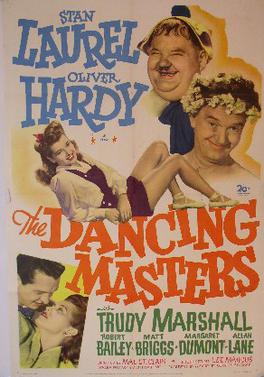
The Dancing Masters is a 1943 black and white American comedy film directed by Malcolm St. Clair, produced by 20th Century-Fox, and featuring Laurel and Hardy. A young Robert Mitchum has a small, uncredited role as a gangster posing as an insurance salesman.
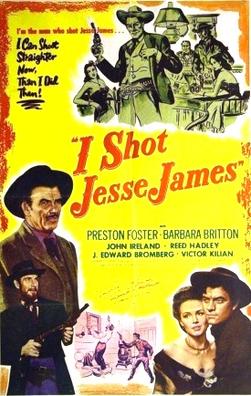
I Shot Jesse James is a 1949 American Western film starring Reed Hadley as Jesse James and John Ireland as Bob Ford. Directed by Samuel Fuller in his debut behind the camera, it portrays the murder of Jesse James by Robert Ford and Robert Ford's life afterwards. The story is built around a fictional rivalry between Ford and his eventual killer Edward O’Kelley over a woman.
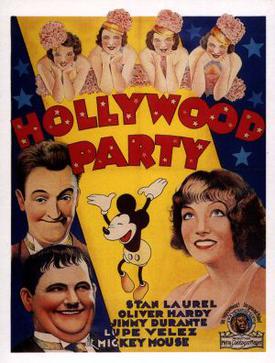
Hollywood Party, also known under its working title of The Hollywood Revue of 1933 and Star Spangled Banquet, is a 1934 American pre-Code musical film starring Laurel and Hardy, The Three Stooges, Jimmy Durante, Lupe Vélez and Mickey Mouse. It was distributed by Metro-Goldwyn-Mayer. Each sequence featured a different star with a separate scriptwriter and director assigned.
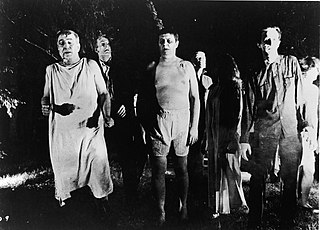
Cinematic exhibition of the B movie, defined as a relatively low-cost genre film, has declined substantially from the early 1980s to the present. Spurred by the historic success of several big-budget movies with B-style themes beginning in the mid-1970s, the major Hollywood studios moved progressively into the production of A-grade films in genres that had long been low-budget territory. With the majors also adopting exploitation-derived methods of booking and marketing, B movies began to be squeezed out of the commercial arena. The advent of digital cinema in the new millennium appeared to open up new opportunities for the distribution of inexpensive genre movies.

Monster from the Ocean Floor is an American 1954 science fiction film about a sea monster that terrorizes a Mexican cove. The film was directed by Wyott Ordung and starred Anne Kimbell and Stuart Wade.

Robert Lenard Lippert was an American film producer and cinema chain owner. He was president and chief operating officer of Lippert Theatres, Affiliated Theatres and Transcontinental Theatres, all based in San Francisco, and at his height, he owned a chain of 139 movie theaters.

Louis Weiss was an American independent producer of low-budget comedies, westerns, serials, and exploitation films.
Hal Roach's Streamliners are a series of featurette comedy films created by Hal Roach that are longer than a short subject and shorter than a feature film, not exceeding 50 minutes in length. Twenty of the 29 features that Roach produced for United Artists were in the streamliner format. They usually consisted of five 10-minute reels.

The Yellow Canary is a 1963 American thriller film directed by Buzz Kulik and starring Pat Boone and Barbara Eden. It was adapted by Rod Serling from a novel by Whit Masterson, who also wrote the novel that was the basis for Orson Welles' Touch of Evil. The film was photographed by veteran Floyd Crosby and scored by jazz composer Kenyon Hopkins.

Hollywood Cavalcade is a 1939 American film featuring Alice Faye as a young performer making her way in the early days of Hollywood, from slapstick silent pictures through the transition from silent to sound.

Roaring City is a 1951 American crime film produced and directed by William Berke for Spartan Productions and released by the low-budget Lippert Pictures. The film stars Hugh Beaumont, Edward Brophy and Richard Travis. It is a "dual purpose" B movie, meaning it could contain two story lines so that it could be released as two half hour television shows later. A private detective investigated a boxer's sudden death in San Francisco.
Edward Francis Finney (1903–1983) was an American film producer and director. He is best known as the man who introduced cowboy singer Tex Ritter to the moviegoing public.

Stan & Ollie is a 2018 biographical comedy-drama film directed by Jon S. Baird. The script, written by Jeff Pope, was inspired by Laurel and Hardy: The British Tours by A.J. Marriot which chronicled the later years of the comedy double act Laurel and Hardy; the film stars Steve Coogan and John C. Reilly as Stan Laurel and Oliver Hardy. The film focuses on details of the comedy duo's personal relationship while relating how they embarked on a gruelling music hall tour of the United Kingdom and Ireland during 1953 and struggled to get another film made.
References
- ↑ Davis p.84
- ↑ MacGillivray, Scott, Laurel and Hardy: From the Forties Forward, iUniverse, 2009, p. 185. ISBN 978-1-4401-7239-7.
- ↑ Robert L. Lippert|Biography|AllMovie